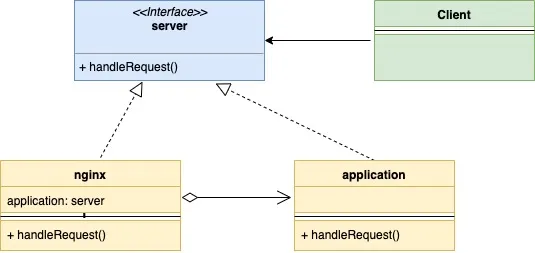GoLang设计模式24 - 代理模式
代理模式是一种结构型设计模式。这种模式建议在访问对象时,添加一个额外的控制层,以便更灵活智能得对访问进行管理。
在这种模式中,会实现主对象的接口创建一个新的代理类。这让我们在执行主对象的逻辑前可以做一些额外的行为。看两个例子吧:
1. 信用卡可以视为是银行账户的代理。它的操作逻辑和银行账户相同,但却更容易使用。
2. 诸如Nginx这样的web服务器可以视为是应用服务器的代理,它可以起到如下的作用:
* 控制对应用服务器的访问,比如执行限流
* 做一些额外的动作,比如做一些缓存
看下代理模式的UML类图:

简单介绍下类图中的成员:
* `Subject`: 代表了主对象类(`realSubject`)和代理类(`proxy`)都需要实现的接口
* `Proxy`: 代表了代理类,在代理类中会嵌入`realSubject`实例,在它自己做完对请求的处理后,会将请求传递给`realSubject`实例进行操作
* `RealSubject`: 主对象类,包含了真实的业务逻辑,在代理模式中被置于代理类之后
* `Client`: 场景类,和代理类及主对象类都进行交互,因为二者实现了相同的接口
下面是前面介绍的nginx和应用服务器的例子所对应的类图:

下面是代码:
server.go:
1 2 3 | type server interface { handleRequest(string, string) (int, string)} |
application.go
1 2 3 4 5 6 7 8 9 10 11 12 | type application struct {}func (a *application) handleRequest(url, method string) (int, string) { if url == "/app/status" && method == "GET" { return 200, "Ok" } if url == "/create/user" && method == "POST" { return 201, "User Created" } return 404, "Not Ok"} |
nginx.go
1 2 3 4 5 6 7 8 9 10 11 12 13 14 15 16 17 18 19 20 21 22 23 24 25 26 27 28 29 30 31 32 | type nginx struct { application *application maxAllowedRequest int rateLimiter map[string]int}func newNginxServer() *nginx { return &nginx{ application: &application{}, maxAllowedRequest: 2, rateLimiter: make(map[string]int), }}func (n *nginx) handleRequest(url, method string) (int, string) { allowed := n.checkRateLimiting(url) if !allowed { return 403, "Not Allowed" } return n.application.handleRequest(url, method)}func (n *nginx) checkRateLimiting(url string) bool { if n.rateLimiter[url] == 0 { n.rateLimiter[url] = 1 } if n.rateLimiter[url] > n.maxAllowedRequest { return false } n.rateLimiter[url] = n.rateLimiter[url] + 1 return true} |
main.go
1 2 3 4 5 6 7 8 9 10 11 12 13 14 15 | func main() { nginxServer := newNginxServer() appStatusURL := "/app/status" createUserURL := "/create/user" httpCode, body := nginxServer.handleRequest(appStatusURL, "GET") fmt.Printf("\nUrl: %s\nHttpCode: %d\nBody: %s\n", appStatusURL, httpCode, body) httpCode, body = nginxServer.handleRequest(appStatusURL, "GET") fmt.Printf("\nUrl: %s\nHttpCode: %d\nBody: %s\n", appStatusURL, httpCode, body) httpCode, body = nginxServer.handleRequest(appStatusURL, "GET") fmt.Printf("\nUrl: %s\nHttpCode: %d\nBody: %s\n", appStatusURL, httpCode, body) httpCode, body = nginxServer.handleRequest(createUserURL, "POST") fmt.Printf("\nUrl: %s\nHttpCode: %d\nBody: %s\n", appStatusURL, httpCode, body) httpCode, body = nginxServer.handleRequest(createUserURL, "GET") fmt.Printf("\nUrl: %s\nHttpCode: %d\nBody: %s\n", appStatusURL, httpCode, body)} |
输出内容:
1 2 3 4 5 6 7 8 9 10 11 12 13 14 15 16 17 18 19 | Url: /app/statusHttpCode: 200Body: OkUrl: /app/statusHttpCode: 200Body: OkUrl: /app/statusHttpCode: 403Body: Not AllowedUrl: /app/statusHttpCode: 201Body: User CreatedUrl: /app/statusHttpCode: 404Body: Not Ok |
代码已上传至GitHub: zhyea / go-patterns / proxy-pattern
END!!
仅是学习笔记,难免出错,望不吝指点




【推荐】国内首个AI IDE,深度理解中文开发场景,立即下载体验Trae
【推荐】编程新体验,更懂你的AI,立即体验豆包MarsCode编程助手
【推荐】抖音旗下AI助手豆包,你的智能百科全书,全免费不限次数
【推荐】轻量又高性能的 SSH 工具 IShell:AI 加持,快人一步
· 分享一个免费、快速、无限量使用的满血 DeepSeek R1 模型,支持深度思考和联网搜索!
· 25岁的心里话
· 基于 Docker 搭建 FRP 内网穿透开源项目(很简单哒)
· ollama系列01:轻松3步本地部署deepseek,普通电脑可用
· 闲置电脑爆改个人服务器(超详细) #公网映射 #Vmware虚拟网络编辑器